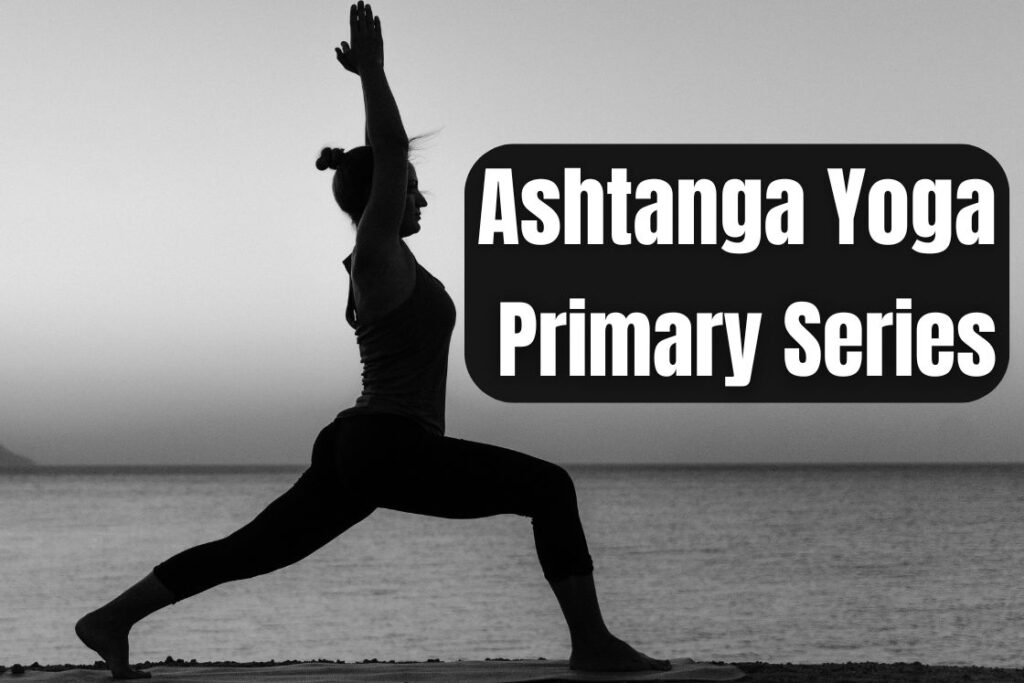
Ashtanga Yoga is a dynamic and disciplined style of yoga, often practised by those who have developed strength, flexibility, and stamina through consistent effort. It requires dedication and patience each posture must be mastered before moving on to the next.
In this method, postures are linked through flowing vinyasa movements, synchronising each transition with a steady breath (ujjayi pranayama). The system follows six fixed sequences, from foundational to advanced, and is taught in the same order around the world, making it a truly global practice.
This article focuses on the Primary Series the first sequence in Ashtanga Yoga exploring its structure, purpose, and how it lays the groundwork for deeper levels of practice.
What is primary series in ashtanga yoga?
The Primary Series is the starting point of Ashtanga Yoga, providing the base for all other series. It is a set vinyasa sequence, where each posture flows into the next in harmony with a measured breath count. This coordination of movement and breath develops both physical strength and mental focus.
First introduced by Sri K. Pattabhi Jois in Mysore, India, the Primary Series is often used as a daily practice for committed Ashtanga students. In Sanskrit, it is called Yoga Chikitsa, meaning “yoga therapy,” because the sequence is believed to purify and strengthen the body while calming and focusing the mind.
Although it is the first series, many practitioners consider it one of the most challenging. It demands stamina, precision, and mindful alignment. Through this sequence, students gain familiarity with vinyasa transitions and the discipline of the Ashtanga method, building the foundation required for the intermediate and advanced series that follow.
Benefits of the ashtanga yoga primary series
YThe postures of the Primary Series are arranged in a precise vinyasa sequence designed to create subtle yet powerful therapeutic effects. This flow helps cleanse the body’s nadis (energy channels), allowing prana the life force to move more freely. When energy flows without obstruction, the body begins to heal, purify, and restore balance naturally.
With a clearer energy flow, you may notice improvements in concentration, confidence, willpower, and overall mind body awareness.
On a physical level, the Primary Series builds strength and flexibility, especially in the core, upper body, and legs. The forward folds, backbends, and twists in the sequence help release stiffness, improve posture, and support spinal health. These movements also aid in detoxifying the nervous system.
The dynamic nature of the practice generates internal heat, which supports the release of toxins through sweat. Combined with specific drishti (gaze points) and controlled breathing, this heat fosters focus, discipline, and meditative awareness throughout the practice.
Ashtanga primary series sequence(poses)
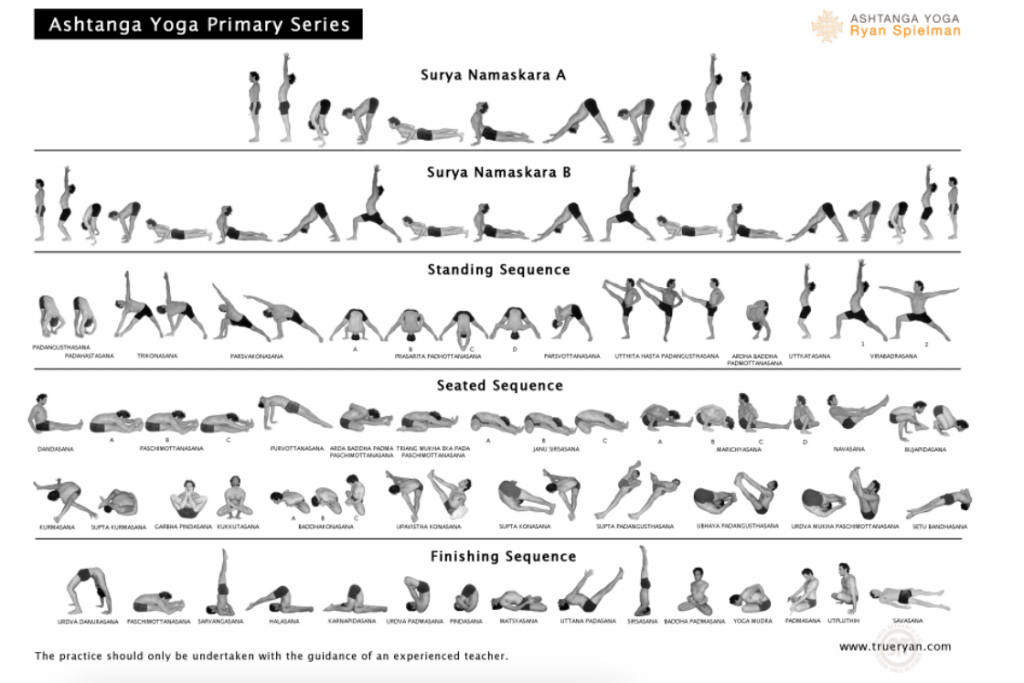
The Primary Series of Ashtanga Yoga follows a fixed order of postures, traditionally taught in the Mysore style. Before beginning the sequence, practitioners perform five rounds each of Sun Salutation A (Surya Namaskara A) and Sun Salutation B (Surya Namaskara B) to warm up the body, build heat, and prepare the muscles and joints.
The Primary Series is divided into four parts:
- Standing Sequence – 13 foundational standing postures that build strength, balance, and alignment.
- Seated Sequence – 20 seated postures linked with vinyasa transitions to develop flexibility, hip opening, and core stability.
- Finishing Sequence – 13 postures including gentle backbends, shoulder stands, and other inversions to restore balance and calm the nervous system.
- Final Three Postures – a short closing set, ending with Shavasana (Corpse Pose) for deep rest and integration.
In total, the Primary Series includes 49 postures and 35 vinyasas. The sequence is learned progressively: a certified Ashtanga Yoga teacher first guides students through each asana with its correct vinyasa count. Once memorised, students practise the sequence independently in class while the teacher offers hands-on adjustments and individual guidance.
All Ashtanga Yoga classes start with an opening mantra. The opening chant is as follows:
Om
Vande Gurunam Charanaravinde
Sandarshita Svatma Sukava Bodhe
Nih Sreyase Jangalikayamane
Samsara Halahala Mohashantyai
Abahu Purushakaram
Shankhacakrsi Dharinam
Sahasra Sirasam Svetam
Pranamami Patanjalim
Om
Through this mantra, you are ideally bowing down to your guru and invoking the blessings of the sage Patanjali.
You then start with Surya Namaskar A and B which are performed 5 times. Then it goes as follows;
1. Standing sequence
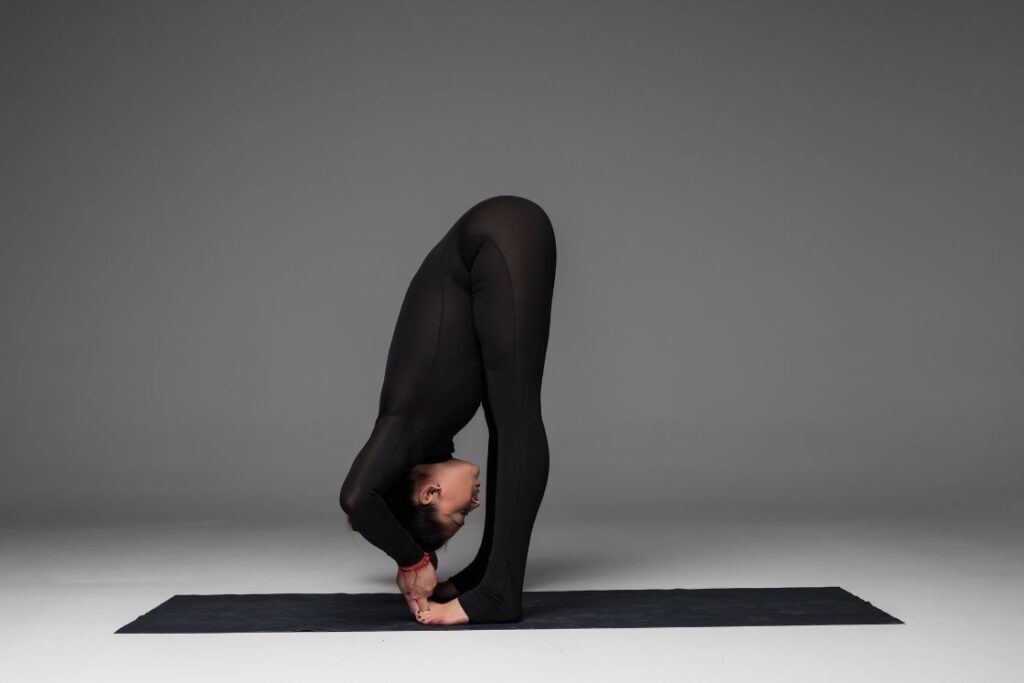
The Standing Sequence is the first part of the Ashtanga Yoga Primary Series and focuses on building strength, stability, and proper alignment. It also sets the rhythm of movement and breath that continues throughout the practice.
The sequence begins with two forward folds:
- Padangusthasana (Big Toe Pose)
- Padahastasana (Hands-to-Feet Pose)
In both postures, the drishti (gaze point) is directed toward the nose. These asanas lengthen the spine, stretch the hamstrings, and prepare the body for deeper folds.
Next comes a series of standing postures for balance and hip opening:
This is followed by two wide-legged forward folds:
The sequence continues with balancing poses:
The first vinyasa transition in the standing sequence begins from Utkatasana (Fierce or Chair Pose), moving into Virabhadrasana I (Warrior I) and Virabhadrasana II (Warrior II). The drishti in Warrior I is on the thumbs; in Warrior II, it is over the front hand. These postures engage the legs, strengthen the core, and cultivate focus before moving into the seated sequence.
2. Seated sequence
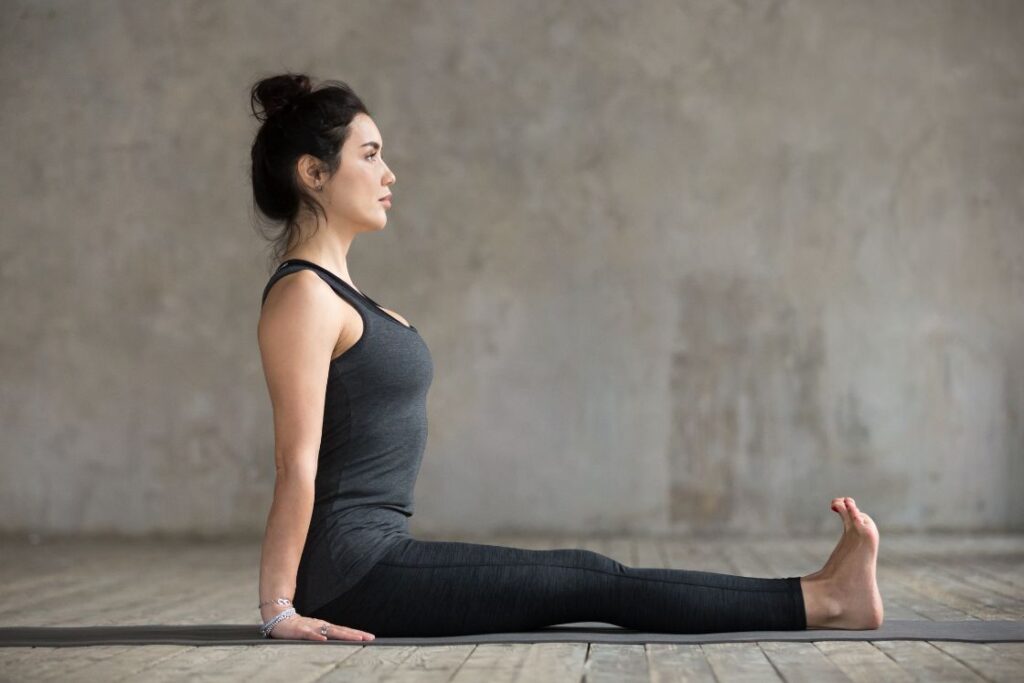
After the strengthening and stabilising Standing Sequence, the Seated Sequence shifts the practice inward, calming the mind and deepening flexibility. This part of the Primary Series is often described as its heart, blending forward folds, twists, and hip openers that enhance focus and release tension.
The sequence begins with:
Next come deeper hip openers and folds:
The sequence then moves into therapeutic folds and twists:
- Janu Sirsasana A–C (Head-to-Knee Forward Bend variations) — drishti: foot
- Marichyasana A–D (Sage Marichi’s Pose variations) — drishti: alternating between foot, nose, and side gaze depending on the variation
From here, you transition into strengthening poses:
Challenging arm balances and forward folds follow:
Next is the family of angle poses, performed three times:
- Baddha Konasana (Bound Angle Pose) — drishti: nose
- Upavistha Konasana (Seated Angle Pose) — drishti: third-eye
- Supta Konasana (Sleeping Angle Pose) — drishti: nose
The sequence concludes with reclining and backbend postures:
- Supta Padangusthasana (Lying Thumb-to-Foot Pose) — drishti: foot
- Ubhaya Padangusthasana (Both Thumbs-to-Feet Pose) — drishti: nose
- Urdhva Mukha Paschimottanasana (Upward-Facing Forward Stretch) — drishti: foot
- Setu Bandhasana (Bridge Pose) — drishti: nose
- Urdhva Dhanurasana (Upward Bow Pose) — drishti: nose
- Paschimottanasana (Extended West Stretch) — drishti: foot
From here, the practice transitions into the Finishing Sequence, which restores balance and prepares the body and mind for closure.
3. Finishing sequence
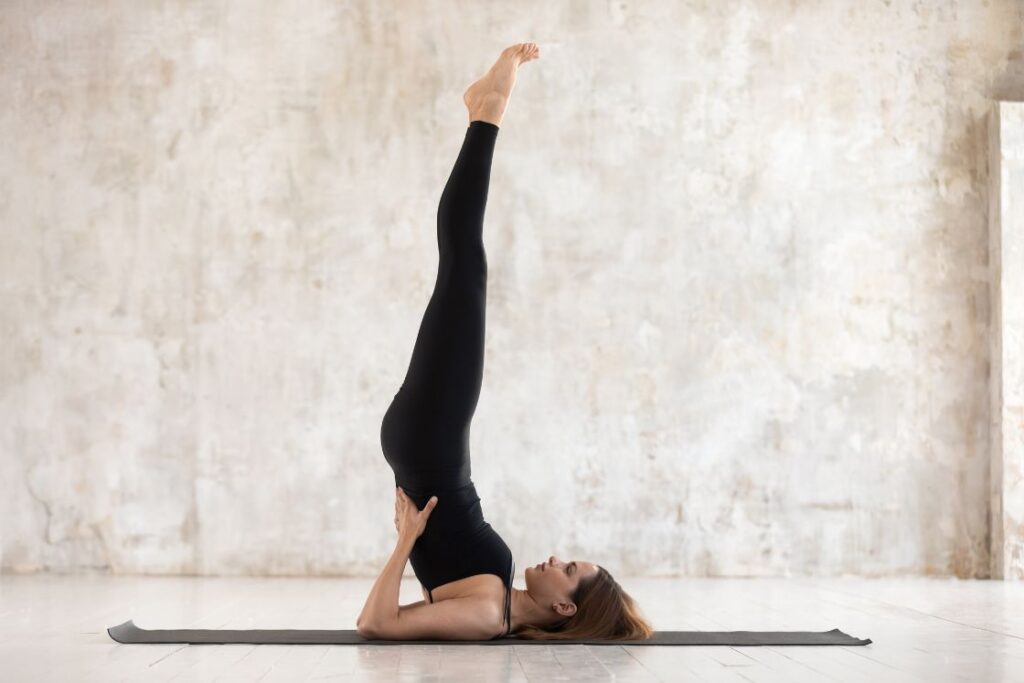
The Finishing Sequence marks the closing stage of the Primary Series. These postures slow the pace of practice, deepen the breath, and prepare the body and mind for rest. Many of the asanas are gentle inversions, which help improve blood circulation, calm the nervous system, and promote mental clarity.
The sequence begins with:
From here, the focus shifts to seated and balancing postures:
- Utpluthi Padmasana (Elevated Lotus Pose) — drishti: nose
- Pindasana (Embryo Pose) — drishti: nose
- Matsyasana (Fish Pose) — drishti: nose
- Uttana Padasana (Extended Foot Pose) — drishti: nose
The sequence then includes inversions that challenge balance and control:
- Sirsasana (Headstand) — drishti: nose
- Urdhva Dandasana (Upward Staff in Headstand) — drishti: nose
Before transitioning to the final postures, practitioners rest briefly in Balasana (Child’s Pose) drishti: nose. The practice then concludes with Padmasana (Bound Lotus Pose) — drishti: nose — followed by Shavasana (Corpse Pose) for complete relaxation and integration of the practice
4. Final three postures
You will now be entering the calming stage where the asanas will prepare you for the ultimate asana. First, you will be practising Yoga Mudra (drishti – third eye), followed by Lotus Pose (drishti – nose) and Lifted Lotus (drishti – nose).
The final pose to end the primary series is the Corpse Pose which is performed with closed eyes and rest for 10-15 minutes.
At the end of the class, you will chant the closing ashtanga yoga mantra that marks the peaceful end.
Om
Svasthi Praja Bhyaha Pari Pala Yantam
Nya Yena Margena Mahim Mahishaha
Go Brahmanebhyaha Shubamastu Nityam
Lokah Samastah Sukhino Bhavantu
Om Shanti Shanti Shantihi
How long does it take to complete the primary series?
The time it takes to complete the Primary Series depends on each student’s pace, experience, and physical condition. On average, a full Primary Series practice lasts about 90 minutes from the opening mantra to Shavasana.
However, mastering the sequence is a longer journey. For some, it may take a month or two to become comfortable with all the postures; for others, it could take longer. Flexibility, strength, body type, and previous yoga experience all play a role in how quickly progress is made.
Rather than focusing on speed, the emphasis in Ashtanga Yoga should always be on quality of movement, synchronisation of breath with vinyasa, and maintaining proper alignment in each asana. Patience and consistency will naturally lead to deeper understanding and mastery over time.
Can beginners perform the primary series?
If you are completely new to yoga, it’s best to first build a foundation with basic postures and breathing techniques before attempting the full Primary Series. This sequence demands strength, stability, flexibility, and mental focus qualities that develop gradually with consistent practice.
Beginners can start by learning a Half Primary Series, which introduces key postures at a slower pace. This allows the body to adapt while maintaining the breath–movement connection that defines vinyasa practice.
Because the Primary Series is physically demanding, prior experience with some intermediate-level yoga poses can be helpful. This prepares the body for the stamina and concentration needed to hold each posture with correct alignment. Practising under the guidance of a certified Ashtanga teacher ensures a safe and effective progression into the full series.
Conclusion
The Primary Series may feel challenging at first, but remember every yoga pose was once new to you. With steady practice, focus, and dedication, your body and mind will gradually adapt. Although many asanas in this sequence are advanced, you will only progress to the next posture when both you and your teacher feel you are ready.
Move at your own pace and avoid comparing your journey with others. Breathe deeply through each movement and maintain your Drishti to help your mind stay centred and free from distractions. In time, what once felt impossible will become part of your natural flow.

